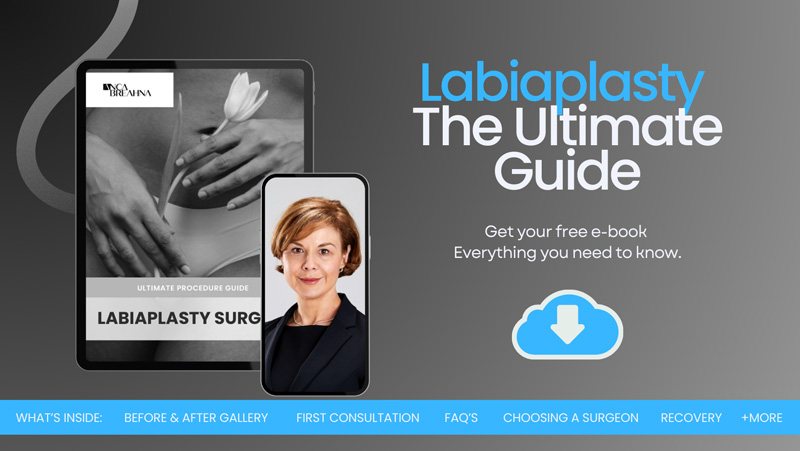
Table of Contents
An Overview of Labial Hypertrophy
Labial hypertrophy, characterised by the enlargement of the labia minora or majora, affects many women and can lead to both physical discomfort and emotional distress. This condition, while not often discussed openly due to cultural sensitivities, warrants a better understanding due to its impact on a woman’s health and well-being.
Download Anca Breahna’s Labiaplasty Guide

Symptoms of Labial Hypertrophy
Labial hypertrophy can present with a variety of symptoms that impact both physical comfort and emotional well-being. The most common symptoms experienced by women with this condition are outlined in detail below:
- Physical Discomfort and Pain: Women with enlarged labia often experience discomfort or pain during daily activities such as walking, exercising, or sitting for extended periods. The excess tissue can cause chafing and irritation, particularly when wearing tight-fitting clothing or during vigorous physical activity.
- Hygiene Difficulties: Managing personal hygiene can be challenging due to the size of the labia. The excess tissue may trap moisture, leading to an increased risk of yeast or bacterial infections. Women may find it difficult to thoroughly clean the area, which can exacerbate discomfort and lead to more severe health issues.
- Urinary Tract Issues: The enlarged labia can affect the urinary tract by obstructing the flow of urine, which can result in frequent infections or discomfort during urination. Some women may also experience urinary incontinence as a secondary symptom.
- Sexual Discomfort: Many women report discomfort or pain during sexual activities. The enlarged labia can be sensitive or prone to tearing, leading to pain during intercourse and decreased sexual satisfaction. This physical symptom can also have psychological repercussions, affecting a woman’s sexual confidence and intimacy with her partner.
- Psychological Impact: Beyond the physical symptoms, labial hypertrophy can significantly impact mental health. Many women feel self-conscious or embarrassed about the appearance of their labia, which can lead to anxiety, depression, or body image issues. This psychological distress is compounded by the lack of open discussion and awareness surrounding the condition.
- Visual Appearance and Self-Esteem: For some, the appearance of their labia can lead to negative self-perception and emotional distress.
Addressing these symptoms is important for improving the quality of life for those affected. Consultant Plastic Surgeon Anca Breahna often recommends a combination of treatments depending on the severity and impact of the symptoms. Non-surgical approaches such as lifestyle adjustments, improved hygiene practices, and therapeutic interventions can help manage symptoms effectively. In cases where physical discomfort or psychological impact is significant, surgical options like labiaplasty might be considered to reshape and reduce the size of the labia, providing relief from both physical and emotional symptoms.
By understanding and acknowledging the range of symptoms associated with labial hypertrophy, you can seek appropriate treatment and support, leading to improved health outcomes and emotional well-being.
Treatment Options
While surgical intervention through labiaplasty is the most known treatment, it is essential to approach the condition holistically:
- Non-Surgical Treatments: For some, managing symptoms without surgery is preferable. This can include the use of specialised garments that provide better support and reduce discomfort. Topical treatments and physiotherapy can also help manage pain and irritation.
- Counselling and Support: Psychological support through counselling can be beneficial for those affected by the emotional distress caused by labial hypertrophy. Support groups and forums can also provide a community and safe space to discuss the condition openly.
- Surgical Treatments: Labiaplasty, which involves the reshaping of the labia, remains a common surgical option. It is crucial that this surgery is performed by a qualified cosmetic or plastic surgeon, and the patient is fully aware of the potential risks and benefits.
FAQs about Enlarged Labia

What is labial hypertrophy and why does it occur?
Labial hypertrophy is an anatomical condition characterised by the enlargement of the labia minora or majora beyond what is typically observed. This condition can occur congenitally, where women are born with it, or it can develop over time due to hormonal changes during puberty, pregnancy, or menopause. The exact cause is not definitively known but is thought to be linked to genetic predispositions and hormonal influences.
What are the implications of labial hypertrophy on daily life and how is it treated?
Labial hypertrophy can cause various physical discomforts such as irritation from clothing, challenges with hygiene maintenance due to the trapping of moisture, and discomfort during physical activities. These symptoms may lead to broader emotional or psychological effects, including self-consciousness or anxiety about the physical appearance or discomfort. Treatment is tailored to your specific symptoms and can range from lifestyle adjustments, such as wearing looser clothing, to surgical interventions like labiaplasty. Labiaplasty should be performed by an experienced surgeon and involves reshaping the labia to alleviate discomfort and improve the appearance, but it comes with risks such as scarring and changes in sensation.
Can changes in lifestyle alleviate symptoms without medical intervention?
Yes, many women find that by making simple lifestyle adjustments, they can manage or significantly reduce the symptoms of labial hypertrophy without resorting to medical procedures. Choosing breathable, loose-fitting clothing and maintaining rigorous hygiene can prevent irritation and discomfort. For those experiencing psychological distress, counselling or support groups may provide relief and improve quality of life by addressing body image concerns and providing emotional support.
What should I consider before deciding on labiaplasty for labial hypertrophy?
Before deciding on labiaplasty, it’s important to consider both the potential benefits and the risks involved. Benefits can include reduced physical discomfort, improved ability to engage in activities like sports or exercise without irritation, and increased confidence and comfort with one’s body image. However, potential risks include complications such as infection, changes in sensation, dissatisfaction with the results, and the need for revision surgery. Thorough consultation with a plastic surgeon who specialises in this procedure is essential to discuss your specific goals, health considerations, and to understand the recovery process. They will help assess whether this surgical option is suitable for your condition and discuss any alternative treatments that might be appropriate.
Medical References about Enlarged Labia
- Classification of labia minora hypertrophy – Science Direct
- The Size of Labia Minora and Perception of Genital Appearance
- Labia Minora, Labia Majora, and Clitoral Hood Alteration: Experience-Based Recommendations
- Perception of Labial Size and Objective Measurements-Is There a Correlation?
- Labiaplasty: motivation, techniques, and ethics
Further Reading
- Read Anca’s Procedure on Labiaplasty
- Read Anca’s Procedure on Desirial Injections (Vaginal Dryness)
- Read Anca’s Blog on Wedge Technique for Labia Minora Reduction
- Read Anca’s Blog on Treatments and Solutions for Enlarged Labia
- Read Anca’s Blog on Labiaplasty Types – Trim Labiaplasty and Wedge Labiaplasty or Hybrid
- Read Anca’s Blog on Labiaplasty vs Vaginoplasty
- Read more about What Are Large Labias? – Causes and Treatments






